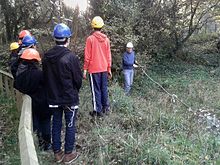- London Wildlife Trust (LWT), founded in 1981, is the local nature conservation charity for Greater London. It is one of 47 members of the Royal Society of Wildlife Trusts (known as The Wildlife Trusts), each of which is a local nature conservation charity for its area.[1][2] The Trust aims to protect London's wildlife and wild spaces, and it manages over 40 nature reserves in Greater London.[3] One of its campaigns is to turn London's gardens into mini-nature reserves,[4] and it provides education services for schools. Local groups work on reserves and organise walks.[5]
- 1 Nature reserves
- 2 Sites formerly managed by the Trust
- 3 See also
- 4 Notes
- 5 References
- 6 Sources
Pond dipping for young and old alike at Gunnersbury Triangle, saved from development in 1983
"Protecting, Restoring and Creating":[8] burning brash from cleared scrub at Ten Acre Wood
In its strategy document, For a Wilder City. London Wildlife Trust 2015–20, the Trust sets out its vision and mission, as well as plans for a five-year period. The trust states its vision as: "A London alive with nature, where everyone can experience and enjoy wildlife."[8] It describes its mission in three parts as "Protecting, Restoring and Creating wild places for nature",[8] "Engaging, Inspiring and Enabling people to connect with nature",[8] and "Championing, Challenging, and Influencing people to stand up for nature".[8] Among its aims for protecting and restoring, the Trust intends to bring 30 of its reserves to "Favourable Condition" by 2020. It plans to restore the Sydenham and Norwood woodlands, and the "Living Landscape" of the Great North Wood, and to reintroduce the water vole to the River Wandle.[14] The Trust's aims for engaging and enabling include building new visitor centres for the reserves at Camley Street, Gunnersbury Triangle, Woodberry Wetlands and Walthamstow Wetlands. and training young people in its "Wild Talent" programme.[15] Its aims for championing nature include creating a London development biodiversity standard, hosting the London Environment Educators' Forum, collaborating on projects across the city, and opening new reserves such as Byng Road (High Barnet), Braeburn Park (Crayford) and Crane Meadows (Heathrow). Recent projects have helped to support pollinators and to conserve the Welsh Harp reservoir.[16] The Trust has three permanent charitable objectives, namely the conservation of places and objects of scientific interest and natural beauty, and of biodiversity, in Greater London;[12] the education of the public, especially young people, in nature conservation, sustainability, and "the appreciation of natural beauty";[12] and research into nature conservation and the use of natural resources.[12]




0 Comment to "love"
Post a Comment